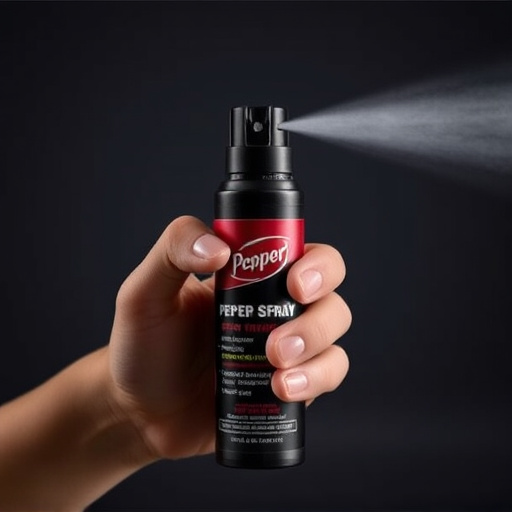Pepper spray, a powerful self-defense tool, uses capsaicin and oleoresin capsicum (OC) to temporarily disable attackers. Variations in spray power among manufacturers depend on compound concentrations, spray pattern designs, and canister sizes. The legal landscape surrounding pepper spray ownership is complex and varies by region, with manufacturers advocating responsible usage and collaborating with authorities for compliance. Choosing the right pepper spray involves balancing range, potency, duration of effect, ease of use, and safety features. Reputable manufacturers offer guarantees and instructions, crucial for first-time users navigating local self-defense laws.
In today’s world, understanding self-defense options like maximum strength pepper spray is crucial for personal safety. This comprehensive guide explores the multifaceted aspects of pepper spray defense, delving into its chemical composition and efficacy through leading pepper spray manufacturers’ insights. We navigate the legal complexities surrounding ownership and use, providing a detailed analysis of key factors to consider when choosing the right spray. By understanding these elements, individuals can make informed decisions to enhance their safety, leveraging the expertise of top pepper spray manufacturers.
- Understanding Pepper Spray: Ingredients and Efficacy – A look into the active compounds, their effectiveness against attackers, and variations in spray power among pepper spray manufacturers.
- Legal Aspects of Pepper Spray Ownership – Exploring the legal landscape surrounding pepper spray possession, use, and restrictions imposed by different regions, with insights from various pepper spray manufacturers' perspectives.
- Choosing the Right Pepper Spray: Factors to Consider – A comprehensive guide on factors that influence spray selection, including range, potency, duration of effect, ease of use, and safety features offered by leading pepper spray manufacturers.
Understanding Pepper Spray: Ingredients and Efficacy – A look into the active compounds, their effectiveness against attackers, and variations in spray power among pepper spray manufacturers.
Pepper spray, a powerful self-defense tool, has evolved significantly since its inception. At its core, it’s a potent irritant that temporarily disables an attacker by causing severe discomfort and pain in the eyes, nose, and respiratory system. The key active compounds in pepper spray include capsaicin, oleoresin capsicum (OC), and various other natural or synthetic chemicals. Capsaicin, commonly found in chili peppers, is the primary ingredient known for its intense heat and irritation-inducing properties. OC, derived from chili peppers as well, offers a broader spectrum of effects, enhancing the spray’s overall effectiveness.
Variations in spray power among pepper spray manufacturers can be attributed to differences in active compound concentrations, spray pattern design, and canister size. High-quality pepper sprays typically contain concentrations ranging from 1% to 2% capsaicin, ensuring maximum potency without causing prolonged harm. Manufacturers also employ advanced spray technology, such as precision nozzles that direct the spray accurately, maximizing its impact distance and effectiveness against attackers. Each brand has its unique formulation and delivery system, catering to diverse user needs and preferences in the self-defense market, where pepper spray manufacturers continuously innovate to enhance safety and security.
Legal Aspects of Pepper Spray Ownership – Exploring the legal landscape surrounding pepper spray possession, use, and restrictions imposed by different regions, with insights from various pepper spray manufacturers' perspectives.
The legal status of pepper spray ownership varies widely across regions, with each jurisdiction establishing its own set of rules and restrictions. While some areas permit individuals to carry pepper spray for self-defense purposes, others have stringent regulations or outright bans. Pepper spray manufacturers often advocate for responsible usage and suggest that their products be employed as a last resort when facing an imminent threat. They also emphasize the importance of understanding local laws, which can differ significantly from one place to another. For instance, some regions may require individuals to register their pepper spray, while others might limit its sale to licensed professionals or law enforcement agencies.
From the perspective of pepper spray manufacturers, compliance with regional regulations is a critical aspect of responsible business practices. They collaborate closely with authorities to ensure that their products meet local safety and quality standards. By staying informed about legal developments, manufacturers can provide accurate guidance to consumers, helping them navigate the complexities of pepper spray possession and use in their respective areas. This dynamic interplay between industry insights and legislative frameworks contributes to a more nuanced understanding of pepper spray defenses within diverse legal landscapes.
Choosing the Right Pepper Spray: Factors to Consider – A comprehensive guide on factors that influence spray selection, including range, potency, duration of effect, ease of use, and safety features offered by leading pepper spray manufacturers.
When choosing the right pepper spray, several key factors come into play. Range is a crucial consideration; closer proximity ensures greater effectiveness but also implies easier dodging by assailants. Potency, measured in SCU (spray units), determines the intensity of irritation and immobilization. Longer-lasting effects provide more time to escape, making duration of effect another vital spec. Ease of use features like ergonomic designs and simple activation mechanisms are essential for quick deployment during stressful situations.
Safety is paramount; look for spray manufacturers that offer safety mechanisms like child-resistant triggers or automatic shut-off features post-activation. Reputable pepper spray manufacturers often include additional guarantees, usage instructions, and warnings about legal considerations, which can be beneficial for users unfamiliar with local self-defense laws.
In conclusion, understanding the active compounds, legal considerations, and specific factors that determine a pepper spray’s effectiveness is key to choosing the right defense tool. Pepper spray manufacturers offer a range of options catering to different needs, ensuring users can navigate potential threats with confidence. By considering ingredients, potency, and safety features, individuals can make informed decisions, empowering them to protect themselves effectively.
